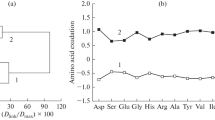Summary
The differences in black spot susceptibility between potato varieties and samples of different origin cannot be explained by differences in tyrosine content or phenoloxidase activity of the tubers. Only 5–15% of the cells in a bruised part of the tissue are damaged and discoloured. Potato tubers, dissimilar in black spot susceptibility, have different potassium and dry matter contents. No differences exist in firmness and osmotic values. If the potassium supply is not limiting growth, the potassium content of potato tubers is about 650 meq. (25,4 g) per kg dry matter. Negligible black spot occurs in potatoes grown on silt soils in The Netherlands if the potassium content of the tubers exceeds 650 meq. per kg dry matter.
Zusammenfassung
Die Unterschiede in der Empfindlichkeit für Blaufleckigkeit zwischen Kartoffelsorten und Mustern verschiedener Herkunft können nicht durch die Unterschiede im Tyrosingehalt oder in der Phenoloxydase-Aktivität der Knollen erklärt werden (Abb. 1, Tabelle 1). Das Fehlen einer Korrelation mit dem Tyrosingehalt und die Tatsache, dass die Änderung dieses Gehalts während der Reifezeit, verglichen mit den Unterschieden zwischen den Sorten, gering ist, weisen darauf hin, dass die Erntezeit, was ihren Einfluss auf den Tyrosingehalt betrifft, das Vorkommen von Blaufleckigkeit nich beeinflusst (Tabelle 2). In einer beschädigten Zelle wird das Tyrosin vollständig in Melanin umgewandelt. Nur 5–15% der Zellen, im gequetschten Teil des Gewebes gleichmässig verteilt, werden verfärbt.
Kartoffelknollen, die in ihrer Empfindlichkeit für Blaufleckigkeit ungleich sind, weisen unterschiedliche Kalium- und Trockensubstanzgehalte auf. Keine Unterschiede bestehen in der Festigkeit des Fleiches und den osmotischen Werten (Tabelle 4).
Wenn die Kaliumgabe das Wachstum nicht beschränkt, beträgt der Kaliumgehalt der Kartoffelknollen ungefähr 650 meq. (25,4 g) pro kg Trockensubstanz (Tabelle 5, Abb. 2). Auf den Tonböden im Südwesten der Niederlande ist es schwierig. Kartoffeln mit einem Kaliumgehalt von über 650 meq. pro kg Trockensubstanz zu erzeugen (Tabelle 6).
Nur geringfügige Blaufleckigkeit kommt bei Kartoffeln aus diesen Böden vor, wenn der Kaliumgehalt 650 meq. pro kg Trockensubstanz übersteigt (Abb. 5).
Résumé
Les différences dans la susceptibilité aux taches noires entre variétés de Pomme de terre et entre échantillons de diverses origines ne peuvent s'expliquer par des différences de teneur en tyrosine ou d'activité de la phénoloxydase des tubercules (Fig. 1, Tableau 1). Ce manque de corrélation avec la teneur en tyrosine et le fait que cette teneur est faible pendant la maturation comparée aux différences variétales suggèrent que le moment de l'arrachage, pour autant qu'il ait une action sur la tyrosine, n'influence pas l'incidence des taches noires (Tableau 2).
Dans une cellule endommagéc la tyrosine est complétement convertie en mélanine. Seulement 5–15% des cellules, réparties uniformément sur la partie contusionnée du tissu, sont décolorées. Des tubercules de Pomme de terre, différents dans leur susceptibilité aux taches noires, ont des teneurs différentes en potassium et matière sèche. On n'aperçoit aucune différence dans la fermeté et valeur osmotique (Tableau 4).
Si un apport complémentaire de potassium ne limite pas la croissance, la teneur des tubercules en cet élément est d'environ 650 méq. (25,4 g) par kg de matière sèche (Tableau 5, Fig. 2). Dans les sols argileux du sud-ouest de la Hollande il est difficile de récolter des pommes de terre avec des teneurs en potassium supérieures à 650 meq. par kg de matière séche (Tableau 6).
L'apparition de taches noires est négligeable dans les tubercules récoltés sur ces sols si la teneur en potassium excède 650 meq. par kg de matière sèche (Fig. 3).
Similar content being viewed by others
References
Jacob, W. C., 1959. Studies on internal black spot in potatoes.Mem. Cornell Univ. agric. Exp. Stn 368.
Lerner, A. B. and Fitzpatrick, Th. B., 1950. Biochemistry of melanin formation.Physiol. Rev. 30: 91–125.
Oortwijn Botjes, J. and Verhoeven, W. B. L., 1927. Het blauw worden van aardappelen.Tijdschr. PlZiekt. 33: 57–96.
Ophuis, B. G., Hesen, J. C. and Kroesbergen, E., 1958. The influence of temperature during handling on the occurrence of blue discolorations inside potato tubers.Eur. Potato J. 1 (3): 48–65.
Udenfriend, S. and Cooper, L., 1952. The chemical estimation of tyrosine and tyramine.J. biol. Chem. 196: 227.
Vertregt, N. and Pannebakker, E. G., 1964. Determination of the discolouration of raw potatoes.Jaarb. Inst. biol. scheik. Onderz. Landb.Gewass. pp. 165–166.
Vertregt, N. and Pannebakker, E. G., 1965. Dopachrome formation in potatoes.Jaarb. Inst. biol. scheik. Onderz. LandbGewass., pp. 113–116.
Author information
Authors and Affiliations
Rights and permissions
About this article
Cite this article
Vertregt, N. Relation between black spot and composition of the potato tuber. Europ. Potato J. 11, 34–44 (1968). https://doi.org/10.1007/BF02365160
Accepted:
Issue Date:
DOI: https://doi.org/10.1007/BF02365160




